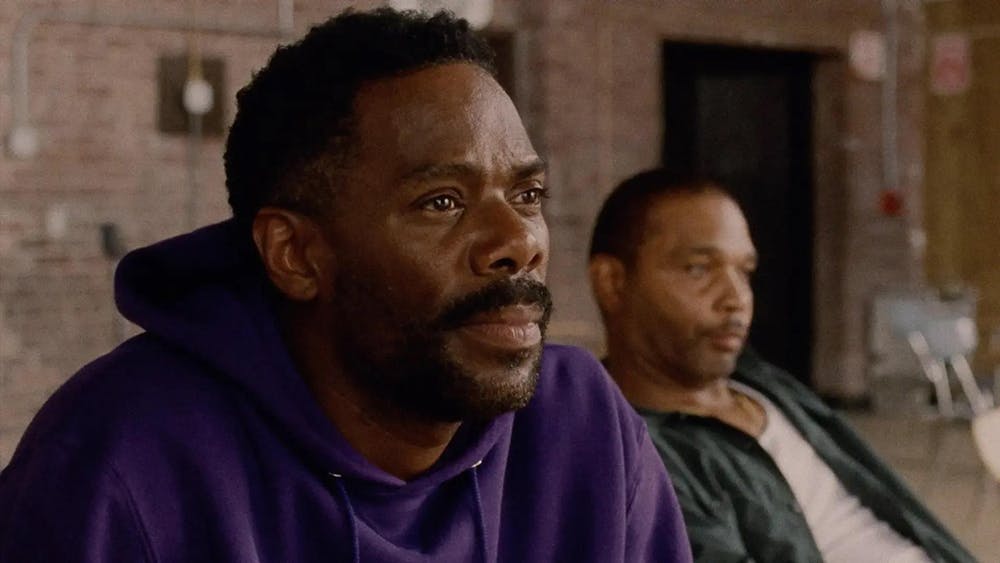We don’t see his face, but we hear him.
In the opening scene of “SING SING,” Greg Kwedar’s new A24 film, lights of midnight blue paint the back of Divine G’s (Colman Domingo) figure as he reads lines from “A Midsummer’s Nights Dream.”
As a man incarcerated at Sing Sing Correctional Facility, a maximum-security prison in upstate New York, Divine G’s world stops at a razor-wire fence. As the camera pans to his face, the pride in his eyes shines through, as if theater has now opened up a third world for Divine G: One where he can be a king, a lovestruck hero or simply a man unafraid in a boundless universe.
“SING SING” follows a theater troupe who frees themselves from the reality of incarceration through the production of a play. Based on the real-life program and friendships made in Rehabilitation Through the Arts — an organization dedicated to helping people in prison through the arts — the film features a cast of formerly incarcerated actors and RTA alumni alongside Hollywood powerhouses like Domingo and Paul Raci, who plays Brent, the program director in the film.
On Wednesday, Ivy Film Festival hosted an advanced screening of “SING SING” as a part of their annual week-long programming.
The film, set to be released in U.S. theaters later this summer, shows that there is immense creativity and community spaces for joy, peace and celebration even in the painful experiences of incarcerated individuals.
While Divine G seems like the leading man of the film’s theater troupe, it soon becomes evident that he is not the only actor bringing change inside the walls of prison.
In a captivating sequence where director Kwedar superimposes scenes of incarcerated people auditioning for their respective roles — clips of tear-filled soliloquies, husky declarations and contagious giggles — audiences begin to see the joy experienced by each man through their relationship to theater.
Before rehearsal begins one day, Brent sits the incarcerated people in a circle and instructs them to get out of their heads, close their eyes and imagine their most “perfect place” for a minute.
In this moment, as the camera pans to each man’s face, a more subtle story is told. Divine G’s most perfect place is eating icees in the summertime, D Dan’s (Sean Dino Johnson) is cutting the lawn in his backyard and for another incarcerated person, it is dancing with girls in his neighborhood. Blaze’s (Jon-Adrian Velasquez) finds bliss in watching the Hudson River ripple with his mother — now, Blaze says with tears in his eyes, she watches him from the other side.
“You guys are becoming actors just by being real and vulnerable with each other,” says Brent. “This isn’t something most guys get to do.”
Over 70% of the New York state prison population is made up of Black and Hispanic individuals, according to the 2023 data report by The New York State Department of Corrections and Community Supervision.
This fact is reflected in the cast of “SING SING,” made up largely of Black and Hispanic men. Throughout the film, some incarcerated people refer to New York neighborhoods where violence, drugs and crime made their coming of age sour in the long run.
“I’m a gangster, that’s my destiny and that’s what’s waiting for me on the outside,” Divine Eye tells Divine G after rehearsals one day. “Sometimes I think I might as well stay here since everyone I know is here,” he adds.
“Then,” Divine G sighs, “they got you if you think you belong here.”
In a society where one’s record defines them after prison — never allowing one to forget their past — RTA offers an opportunity for incarcerated individuals to put their pasts behind them for a moment and live in the now with one another.
“I feel like the inclusion of formerly incarcerated people into the film was poignant and powerful,” said Amiri Nash ’24 after the screening. “The scoring is so important. The writing is so important. And it’s all these little pieces that make something super grand and immersive.”
For Amani Diallo ’27, “SING SING” beautifully portrayed the lives of incarcerated individuals instead of glorifying the system of incarceration.
“It makes me proud to go to Brown, where we are active in the prison archives system,” Diallo said. “We have the archives of Mumia Abu-Jamal and … are using our privilege to give voice and a platform to people who don’t otherwise have it.”
“I’m going to think about the people who are still inside, who are still doing plays over and over and over again” after walking out of the theater, said Diallo. “And I’m going to think about the people in prison who don’t have those resources, and don’t have the opportunity to perform and use art to do any of that.”

Sanai Rashid lives in Long Island, New York. As an English and Economics concentrator, she is passionate about storytelling and how numbers and data create narratives in ways words alone cannot. When she is not writing, you can find her trying new pizza places in Providence or buying another whale stuffed animal.





